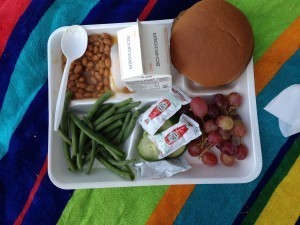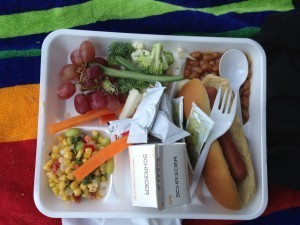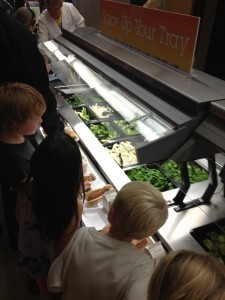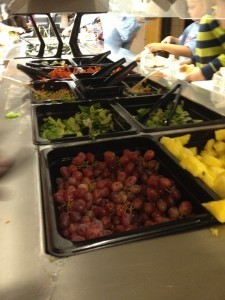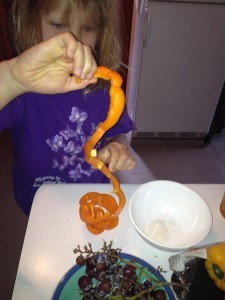Katja Rowell's Blog, page 10
October 24, 2012
“Love Me, Feed Me” Giveaway and Review
 Wanted to share a book review from a reader of Love Me, Feed Me who contacted me after she read the book to do a Giveaway. Honored, and loved her line, “I’ve been following feeding specialist Dr. Rowell’s blog and tweets for a while, and have found her approach to the parent-child feeding relationship so sane that it almost seems insane.” Some days I do feel “insane.”
Wanted to share a book review from a reader of Love Me, Feed Me who contacted me after she read the book to do a Giveaway. Honored, and loved her line, “I’ve been following feeding specialist Dr. Rowell’s blog and tweets for a while, and have found her approach to the parent-child feeding relationship so sane that it almost seems insane.” Some days I do feel “insane.” 
Fostering Thrifty Families blog seems to have lots of great tips and ideas for, as they say, “living well on a budget.” Check them out!
Click here for the full review and details to enter the book give-away…
October 23, 2012
Does your routine help get dinner on the table, or bore you to tears?
 We parent with routine and structure. Serious structure. Maybe it’s the German in me, or maybe it’s because we have had a relatively easy time of things when we are all rested and have even blood sugar levels…It’s worked well for our home from eating to sleeping.
We parent with routine and structure. Serious structure. Maybe it’s the German in me, or maybe it’s because we have had a relatively easy time of things when we are all rested and have even blood sugar levels…It’s worked well for our home from eating to sleeping.
Well last night we had to go to M’s school ‘family science night’ and the pork chops weren’t cooked through, and the mashed potatoes were too milky (I dumped too much in in my haste…) Having to eat dinner an hour earlier threw me off completely. I let M play at the park too long, I pulled out the photos from two years ago that need to go in an album, I lost track of time… (BTW, why do I pick now, when we move in three weeks, to pull out the albums and two years of old photos???)
We are creatures of routine. Unlike my French family, who made every effort to keep living the life they had, with the children fitting in, we fit our life around the schedule that worked best for our child. (This is not judging parents who don’t live by routine, just saying what worked for us. I watched my French relatives with awe and a little jealousy, as they biked to Parisian dinner parties that lasted until early in the morning with the kids along and they all did just fine. I think we had less of an exciting social life to sacrifice if I’m being honest…)
We have had a harmonious, if totally predictable routine. When did it start? I trace it back to when M was 7 1/2 weeks, we warmed up the bathroom with a space heater and gave her a warm bath (no soap, just a natural oil in the water). This was followed by 5-10 minutes of massage, fresh diaper, last bottle, warm jammies, song, then I put her down awake and she slept six hours straight. I’ll tell you we did that same bedtime routine for months, and it sort of cemented our love of routine. Sleep will do that to you.
Meals and dinner are much the same. We eat every 3-4 hours. I start cooking between 5:45 and 6 pm. I peel, wash, or start the potatoes—they ALWAYS take longer than you think. I lay the table while things are simmering, perhaps the rice cooker has been going while we were at the park. Sometimes M helps me lay the table, sometimes I let her play Legos or barbies. Then we sit down to eat between 6:30 and 6:45. Every. Night. And I like it that way, and it works for us, and I’m grateful that I have the time and the predictable routine at this point in time to make it happen. I know some day we will wrestle with evening activities that M desperately wants to do, but for now, I protect those evenings with a passion. I love dinner. I love the food I cook (mostly) and I love chatting with my family. I resent evening activities for cutting into that time. I turn down speaking engagements so I can walk the talk with family meals, because yes, it is that important to me.
We ate the squash standing up and ran out the door with the half-cooked meal on the stove. Sigh. We all did fine, and science night was a blast. We nuked the pork chops and potatoes when we got home, and it was edible, and we went to bed later, and we survived. I will be more careful planning my time when I’m out of my familiar routine, I will not chose those evenings to reminisce over photos of family vacations from years ago…
Are you a creature of routine? Does your routine help get dinner on the table, or bore you to tears? Maybe somewhere in between? What does your afternoon look like?
October 18, 2012
Posting photos of school lunch, could it improve quality?
I feel good about my child eating at school, and I know how lucky I am. Here are more pics of lunches from M’s school, which are posted daily on Facebook. I think if schools had to post photos of their lunches, or if the administrators had to eat school lunch once a week with the kids, things might improve more quickly. And yes, there really is that much cut up fresh fruit at a public school. I honestly don’t know how they do it on their budget…[image error]
Then compare with these photos from Fed Up With Lunch.
How it there that much difference in quality and care, ostensibly on the same budget?
What do you think… Make schools post a daily photo? Require school administrators and teachers to eat lunch with the kids in the cafeteria once a week? (Note, to sit with the kids and enjoy the food, not to police and pressure them to eat more “healthy” choices…)
More lunch photos…
[image error] [image error]
October 15, 2012
School lunch, it was yummy, and I was full…
In honor of school lunch week, today’s post is about M’s lunches. First off, I want to say “Thank you” to all the folks who work in school food services. It is a difficult, often thankless job, and so, so important. (A job, I hear that has been made more difficult with the new regulations’ servings and calorie limits, but I’ve talked about that recently in part 1 and part 2… read the comments where parents share what their children are experiencing.) I don’t know who is cutting up all the fruits and veggies at our schools, but THANK YOU!
So, lunch… The other day was the annual spring BBQ where family members are invited to eat with the kids. I think we are very lucky and probably have some of the best, most appetizing, balanced, well-prepared meals around.
M’s tray with whole-wheat hamburger bun, burger, beans, cucumbers, grapes and green beans
my tray with hot dog and whole wheat bun, corn and edamame salad, broccoli and cauliflower, grapes, carrots
Here are the greens that are available every day. Fresh cut-up cauliflower, mixed greens, raw green beans, jicama sticks, carrot sticks, and I’m probably missing a few. Only downside is that all you can get is fat-free Ranch dressing with it…
Here are the fresh fruits. Grapes, pineapple, further down are carrot sticks and a corn and edamame salad with cilantro. (It seemed watery and bland, likely fat-free dressing with too little seasoning—bad, bad sodium!!)
I was amazed at how orderly the kids were. I heard no complaints, no nagging or pushing, no “ew gross!” It was just there, very matter-of-fact. This is what kids see from Day 1 in Kindergarten, so it’s normal for them.
Alas, from what I hear, this kind of food and experience is not the norm. This is roughly what these kids have been used to at this school, so there hasn’t been any huge transition. My sense is that there are a few more fresh fruit and veggie options with the new regulations, but again, we are so, so lucky. Here is a link to the school lunch calendar if you’re curious. Oh, and there are always wraps or sandwiches for kids who don’t like the main entree.
This was not a typical day, with kids and families eating on the lawn outside the school, but from what M tells me, there are generally no adults patrolling the cafeteria encouraging or insisting that children eat their “healthy” choices, or policing the trash cans. That’s a plus too. No head-game, no pressure to invite resistance from the kids. It was just lunch…
What do you think? Does your kids’ cafeteria look like this? Could it? Inspired to print off the menu and give it to your school administrator? I still don’t like the ‘no seconds’ rule, and still have big issues with the new lunch plan overall, but I think there are places that are doing pretty well, and we can learn from them.
NOTE: I will be out of town the rest of this week, so might not get back to comments right away… I have one auto-post coming midweek about posting pictures of school lunch online…
October 9, 2012
Pepper spiral! Easy, fun way to send veggies in lunches.
I think the picture says it all… M says she always gets comments when she grabs the end of the pepper and pulls it out of the Tupperware in her lunch box. I cut out the stem, then pull out the seeds as best I can, use a good paring knife and see if I can cut the whole thing in one spiral. I then remove any left-over seeds and white parts.
In general, I find that making your child’s food into art, to try to get your kid to eat it, means you may be working too hard, and it might not even be helping. But this pepper trick is quick, easy, I don’t do it every time, and it makes me smile thinking of her pulling that pepper out at lunch.
What do you think? Where is the line between a fun food prep method, and Picasso on a plate? When does it cross into pressure? Cutting pepper spirals, serving food-art every meal? Do you have fun ways of preparing foods? Have you made a fancy food project only to have your child still reject your efforts?
Generally when I work with parents on feeding concerns, asking them to examine their motives, their feelings and the child’s reactions helps them know if their approach is helping or possibly harming.
October 4, 2012
purple potatoes and talking tips
 We made purple mashed potatoes the other night. We didn’t know they’d turn out purple. We had fun, a kind of culinary experiment. As I was chatting with M, it had me thinking about how much I love being in the kitchen with her, and how much fun it is to be curious. It seems in stark contrast with most “nutrition education” or the ways we talk about food as a culture. These purple potatoes provide an interesting study…
We made purple mashed potatoes the other night. We didn’t know they’d turn out purple. We had fun, a kind of culinary experiment. As I was chatting with M, it had me thinking about how much I love being in the kitchen with her, and how much fun it is to be curious. It seems in stark contrast with most “nutrition education” or the ways we talk about food as a culture. These purple potatoes provide an interesting study…
We had cooked purple beans recently, and were surprised to learn that when they were cooked, they lost the purple color and turned green…Perhaps you buy a purple food, maybe something unusual, like a purple potato. Maybe your child helps you peel them or cut them up (maybe not, M passed this time, but did peak in the pot often.)
Dinnertime theater, scene #4, purple potato play
Standard nutrition education approach might look like this:
Mom: “Purple foods are really good for you. They have anti-oxidants that keep you from getting cancer. Can you name another purple vegetable or fruit? If you try two bites at dinner you can have dessert. It’s so important to eat a rainbow every day.”
Consider a different approach to talking about food with young children:
Mom: Do you think these will lose the purple too when we cook them?
M: I don’t know.
Me: I was surprised when the purple beans turned green, were you?
M: Yea, that was weird, they tasted the same too.
Me: Will you throw some salt into the pot? Two big pinches? I wonder if they will lose the purple or if they will taste the same.
Off she went to play Legos.
As we mashed them up with some butter and evaporated milk and salt, I said, “They stayed purple, cool! (M nods and mashes and remarks on the color…) There aren’t lots of purple foods. Can you think of any others?”
M:Grapes?
Me: “Yup, we saw some purple grapes.” Then she was off again. 
If she had said, “Laffy Taffy,” I would have said, “Yup, grape flavor is purple,” maybe added eggplant, or smoothies with strawberries and blueberries… The point is, that it was fun, part of our usual meal-time routine.
When she put them on the plate, she then covered them in ketchup (I will spare you that photo…) and we all thought they were a little more pasty than our usual mashed potatoes, then Dad wondered if we added more evaporated milk if they would taste just like the others… (That night we had green beans and risoles, an English type of meatloaf patty. Yummo!)
What do you think? Thought it would be fun to share some ways of enjoying the wonder of food, without turning it into a “should” lecture about health and nutrition. I know that for many young children sensitive to pressure, all the nutrition talk is a turn-off and makes fruits and veggies less appealing.
October 2, 2012
Does encouraging a “small” child to eat all day work? Lessons from shopping on an emtpy stomach.
 Standard advice parents hear when they worry their child is “too small” or not “eating enough” is to offer and push food all day long. They are told by their child’s doctors and specialists to push Pediasure or high-fat foods, “…any time your child lets you.” I had one call with a client a few years ago who was panting on the phone, out of breath from chasing her toddler with a piece of sausage. My friend had a sippy-cup full of high-calorie drinks that she would put in her toddler’s mouth in the stroller on the way to the park, at the park and on the way home, only to be frustrated when she didn’t touch her lunch.
Standard advice parents hear when they worry their child is “too small” or not “eating enough” is to offer and push food all day long. They are told by their child’s doctors and specialists to push Pediasure or high-fat foods, “…any time your child lets you.” I had one call with a client a few years ago who was panting on the phone, out of breath from chasing her toddler with a piece of sausage. My friend had a sippy-cup full of high-calorie drinks that she would put in her toddler’s mouth in the stroller on the way to the park, at the park and on the way home, only to be frustrated when she didn’t touch her lunch.
Pushing kids to eat, or trying to get a little bit in to them whenever you can, most often backfires and results in children who eat and grow less well. Kids end up “grazing,” or taking in small amounts throughout the day: a bottle with protein powder, a sippy-cup full of Pediasure or milkshakes, only “healthy” choices, crackers…
Often the intake analyses I see with clients worried their child is too small shows a child who is eating a little bit, every 30-60 minutes, often with a lot of nagging and effort. Parents tell me that their children “can’t” feel hunger cues, or never show that they are hungry.
As Hydee, our consulting pediatric RD said, “These children are never allowed the opportunity to develop an appetite.” (I loved how she worded that…)
“Appetite,” or foods being appealing, is seriously bummed out by a few things: stress, anxiety, pressure, and/or constantly having a little something in your tummy. Maybe this analogy will help explain.
Imagine you are shopping for groceries and haven’t eaten for several hours. What is that experience like? Do you, like me, find that everything looks good, that you have all kinds of ideas about what to cook, with several items not on your list finding their way into your cart? Maybe you even notice that more of the high-calorie, high-fats food seem appealing, and you find three bags of your favorite chips in your cart, not the usual one. Maybe you even make a point of visiting all the sample tables. It ALL looks yummy!
Now think about when you shopped after a big and satisfying meal. You stuck to your list, weren’t as tempted by other things, breezed by the free samples with not interest…
It’s similar with children and appetite. Ever heard, “hunger is the best cook?” It’s true. Structure means that at planned meals and snacks, your child has a little hunger, isn’t ravenous, and has the opportunity to develop an appetite. (It also helps to even out blood sugar levels which often helps with behavior.)
So, if you are working hard to get more into your child, maybe fill in the intake form (under Appendix Items, feeding and intake journal) for three days, note when and what your child is eating. If you find your child is eating much more than every 2-3 hours (for younger kids) and 3-4 hours (for older kids), maybe part of why your child is “never hungry” is because well, she’s never hungry.
Consider structuring meals and snacks (the when from the division of responsibility) and see what happens. It might take a few days to see your child learn to listen to cues of hunger, but working on structure is one of the most important ways to help a child with self-regulation and learning to like new foods.
(Check out this free video on how to feed a child you think is too small. How to transition to structure when you feel stuck is discussed in detail in Chapter 4 in Love Me, Feed Me.)
What do you think? Did planning meals and snacks help you or your kids with their eating?
September 27, 2012
meal planning for the whole family
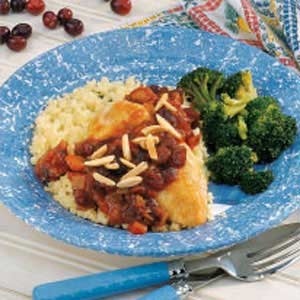 This salsa cranberry dish is a favorite of the grown-ups in the family. Not so much the child. We had it the other night. It’s an easy, fast, delicious, one-pot dinner. We call it “salcranzobuck.” (salsa craisins, garbanzo beans, chicken-buck buck) When I make it with steak, it’s “salcranzomoo.” I know, pretty awful, but it floats our collective boats.
This salsa cranberry dish is a favorite of the grown-ups in the family. Not so much the child. We had it the other night. It’s an easy, fast, delicious, one-pot dinner. We call it “salcranzobuck.” (salsa craisins, garbanzo beans, chicken-buck buck) When I make it with steak, it’s “salcranzomoo.” I know, pretty awful, but it floats our collective boats.
Anyhoo. We had this last night. As an aside, I omit the almonds (too fussy) and dump in a can or garbanzo beans (not in original recipe) for more heartiness and stretching the stew. As I watched M pass on the stew, I thought of planning menus and how hard that can be for many families, hence the inspiration for this post. The good news is, many clients express relief when working on feeding, that they get to enjoy food they want to eat again!
So, I knew that M probably wouldn’t eat SCZB. Though she’s generally an adventurous eater, this one is a texture bonanza, we haven’t had it much, and it’s a little challenging with the sweet fruit and salsa. I also think her knowing the ingredients on this one doesn’t help. (The ingredient list sounded awful to me too, but it comes out like a tagine in a way…)
So, rather than make her macaroni and cheese, or an alternate main dish, I have the expectation that someday she will learn to like SCZB. I consider her tastes, and serve it with couscous and peas (a filling favorite) and plan a dessert she likes— fruit popsicle. M only ate peas and couscous,and her dessert, but she kept us company, enjoyed her meal, and I have faith that one day she is likely to enjoy SCZB, and until then…
Main tips:
Serve foods you want to eat. I love SCZB, I want to eat it, I cook it.
Be sure there is something everyone can satisfy their hunger with, even if it’s just the couscous and milk, or maybe another side dish.
Kids will never learn to like to eat foods they never see. It’s why family meals are so important. It’s why I am not a fan of kids eating “kid food” at the kitchen island while mom and dad eat real food after the kids are in bed… One client told me her kids didn’t like shrimp, and the Dad pointed out they had never had shrimp since moving into their house — five years ago, and three of the kids were under age five.
Think about what your child likes, but don’t limit the menu to only what the child likes. Challenge with new foods, but don’t be mean about it. (I wouldn’t for example serve SCZB with cottage cheese and bananas, or other foods M doesn’t generally like.)
Don’t remind, pressure or beg, even the “one-bite-rule” to try to get your child to like SCZB or any other food. Learning to like new foods is a process that is hard to speed up, and easy to slow down. (If you love the one-bite-rule, and it works great for all your kids who are happy eaters who enjoy variety and self-regulate, then go for it. if however, the OBR leads to a stand-off, it’s not helping…)
Not make her “kid” food as an out. It sends her the message that this is too hard for her, that she can’t learn to like it, and that there are kid and grown up foods.
Don’t tell them what you are thinking. For example, don’t say, “I know you won’t eat this, so I made you peas…” The meal-planning while helping them feel safe and get enough variety and quantity is not something they need to know about.
What do you think? Can you remain calm while your child passes on the main dish?
September 26, 2012
family meals don’t matter? not so fast!
Food for Thought: Do Family Meals Really Make a Difference for Child Academics or Behavior?
This and other recent articles and editorials based on a recent study are suggesting that family meals don’t really matter as much as we think. From the NYT editorial, “So if you aren’t able to make the family meal happen on a regular basis, don’t beat yourself up: just find another way to connect with your kids.” Hmmm, this caught my attention.
From the Food for thought article linked to above:
“We find no relationship between family breakfasts or family dinners and any child outcomes — reading, math and science scores, or behavior problems,” says Miller.
They suggest that if you can’t make family meals happen, talking in the car on the way to soccer is just as good. Is it?
Now, it is a valuable question. Are family meals what matter, or something else? Maybe quality time together, attachment, or parenting style matter more in terms of child outcomes. If it’s really parenting style and not family meals so much, and we can teach effective parenting, maybe that would be a place to put more resources? I’m not opposed to challenging assumptions, even about my beloved family meal, but we do have a responsibility to do good research that answers the questions we want to know.
Now, consider this. Here is how the study defined a “family meal.”
“On how many of the past 7 days was at least one of your parents in the room with you while you ate your evening meal?”
This could be interpreted as standing around the island with everyone eating different foods, watching TV, playing video games, in front of the TV. To me, it misses the very essence of the family meal.
The study is based on a questionable and vague definition of family meal— the very thing they are trying to study the effects of. In my mind then, the conclusions are suspect at best, yet get reported in the lay press as, family meals not so important after all, so don’t sweat it!
Just a quick reminder to take anything you read with a grain of salt.
How do you define a family meal? Do you think this question cuts it or not? BTW, I still think there is immense value in sitting with people you love and sharing food and good company. I felt like I had to put this out there since so many families are working hard to have pleasant family meals. I don’t want anyone to read this headline and feel duped. I think family meals are critical for helping kids learn to feel good about food, and to be happy and healthy people.
September 25, 2012
Love Me, Feed Me is here, like sending my first-grader off to school…
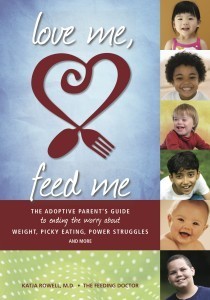
I am thrilled to announce that my book, Love Me, Feed Me, is available on Amazon.com
“I wish I had read Love Me, Feed Me before we had our son with us. It would have saved us so much worry and heartache. Our family has been transformed by the Trust Model and Dr. Rowell’s practical advice. It felt like she was describing our situation to the letter, when we felt like we were the only ones. This book has helped more than I would have imagined, both with our biological son’s picky eating and our adopted son’s intense interest in food. As a bonus, the practical, science-based information will help me take better care of my patients.” — Ruth C., adoptive mother and Family Nurse Practitioner
A few weeks ago, I watched my first-grader get on the bus for her first day of school. With joy, sadness, and butterflies in my stomach, I waved and blew kisses (she still likes when I do that) and wondered how she would go out and touch the world. Would she help a Kindergartner find her room, or leave a “heart-print,” as her teacher calls random acts of kindness?
This unveiling of my book feels similar. Hours of research, reading, writing, re-writing, conversations, interviews, reflections on my interactions with my clients and now, here, in my hand is this book. This 1.7 pound book that I have longed to offer to clients and others who need support desperately. Would this book be on-target? (I think so, at a workshop where I took questions for an hour, almost every single question from these adoptive parents was something I covered in the book.) Will it reach others and help parents transform difficult feeding relationships as I hope it will? As I shipped off the pre-orders last week, I realized I have butterflies for this baby too…
About 18 months ago, I decided to get serious about writing the book when in one day I got calls from two mothers on opposite sides of the country who had adopted little girls from Ethiopia, had been instructed to limit their intake to “prevent obesity,” and had children who were completely obsessed with food as a result. We’re not talking about hoarding and survival behaviors common when children have experienced food scarcity, but prolonged food obsession due to restriction. (This is something I am seeing increasingly in all of my clients, adopted or not as the worry over “obesity” distorts feeding.) These two families were able to turn things around, but I felt compelled to write down the process, the words from mothers like these as a resource for other parents. I dream that if parents read this book before their children are with them, it may prevent “worry and heartache,” as Ruth experienced.
The book is a practical, relationship-building guide for fostering and adoptive parents, but is appropriate for ALL the families I work with. Ironically, by reaching out to the adoptive and fostering communities, it might make parents of biological children think, “Well, this book isn’t for me because my child isn’t adopted.” I hope not. (I wrote the book in part because I heard many an adoptive parent say, “The Trust Model won’t work for us because my child was adopted…”) Interestingly, many families with both biological and adopted children with whom I work notice that all of their children benefit from the Trust Model. (See www.ellynsatter.com)
Why I think LMFM is a great resource (if I do say so myself):
Lots of parents, with children of all ages, share their triumphs and challenges with feeding. Be inspired by parents who have been there. This book is filled with the wisdom of parents.
I bring in a lot of science and the studies that support what I do with clients, but the book is accessible, and even funny at times, so I’m told.
It’s user-friendly with a great index so you can find what you need to know now, and then read the rest in all your free time (ha!)
It outlines the scary transition, explains emerging skills, deals with common obstacles and pit-falls in an accessible way, helps you trust your instincts, recognize when something is working, and when it is harming (feeding therapies for example).
Some folks I really respect have read the book and recommend it. Here is a sampling from the “advance praise” section:
“A must-read for families—especially adoptive ones—but really everyone, because food issues are so rampant today. Rowell tackles the tough issues, and they would have helped my parents when I was adopted and are already helping me with my foster children now . . . This information is desperately needed to help families deal with common challenges that come up involving food. This book shows parents how to build trust and relationships, while avoiding conflict and power struggles.” — Ashley Rhodes–Courter, bestselling author of Three Little Words
“… Love Me, Feed Me is designed to help families understand and rectify feeding problems commonly encountered in children who suffered early deprivation and is one of the best sources of coherent information on this extremely important topic.” — Dana E. Johnson, MD, Ph.D, Professor of Pediatrics, International Adoption Medicine Program, University of Minnesota
So, with excitement and anticipation, I put this book out there with hopes that it will help families find their peace and joy at the family table. For the families where individual consultation isn’t an option, I wanted to get down the essence of a healthy feeding relationship, from the philosophical to the day-to-day practical, that I share with my clients.
What are your struggles with feeding and weight worries? What information are you looking for? If you read the book, I’d love to hear from you, what helped, where you needed to hear more. Thank you all for your comments and support over the years. Now go order the book and tell your friends to as well! Just kidding. Kind of 

